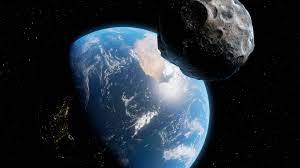Asteroids are chunks of rock left over from the formation of our Solar System. Approximately half a billion asteroids with sizes greater than four metres in diameter orbit the Sun, travelling through our Solar System at speeds up to about 30 kilometres per second – about the same speed as Earth.
Almost every week we see online headlines describing asteroids the size of a “bus”, “truck”, “vending machine”, “half the size of a giraffe”, or indeed a whole giraffe. We have also had headlines warning of “city killer”, “planet killer” and “God of Chaos” asteroids. How many asteroids hit Earth and how many can we expect to zip past us?
What is the threat of a direct hit?
In terms of asteroids hitting Earth, and their impact, the graphic below from NASA summarises the general risks. There are far more small asteroids than large asteroids, and small asteroids cause much less damage than large asteroids.
So, Earth experiences frequent but low-impact collisions with small asteroids, and rare but high-impact collisions with big asteroids. In most cases, the smallest asteroids largely break up when they hit Earth’s atmosphere, and don’t even make it down to the surface.
When a small asteroid (or meteoroid, an object smaller than an asteroid) hits Earth’s atmosphere, it produces a spectacular “fireball” – a very long-lasting and bright version of a shooting star, or meteor. If any surviving bits of the object hit the ground, they are called meteorites. Most of the object burns up in the atmosphere.
How many asteroids fly right past Earth?
A very simplified calculation gives you a sense for how many asteroids you might expect to come close to our planet. Now, let’s take the case of four-metre asteroids. Once per year, on average, a four-metre asteroid will intersect the surface of Earth.
If you doubled that surface area, you’d get two per year. Earth’s radius is 6,400km. A sphere with twice the surface area has a radius of 9,000km. So, approximately once per year, a four-metre asteroid will come within 2,600km of the surface of Earth – the difference between 9,000km and 6,400km. Double the surface area again and you could expect two per year within 6,400km of Earth’s surface, and so on. This tallies pretty well with recent records of close approaches. Astronomers consider anything passing closer than the Moon – approximately 300,000km – to be a “close approach”. “Close” for an astronomer is not generally what a member of the public would call “close”. In 2022 there were 126 close approaches, and in 2023 we’ve had 50 so far. Big asteroids (over 1 km) threaten civilization every half a million years, with thousands of near misses closer than the Moon. Asteroid 153814 (2001 WN5) will pass 248,700 km from Earth in 2029.
How do we assess threats and what can we do about it? Approximately 95% of asteroids of size greater than one kilometre are estimated to have already been discovered, and the skies are constantly being searched for the remaining 5%.

















